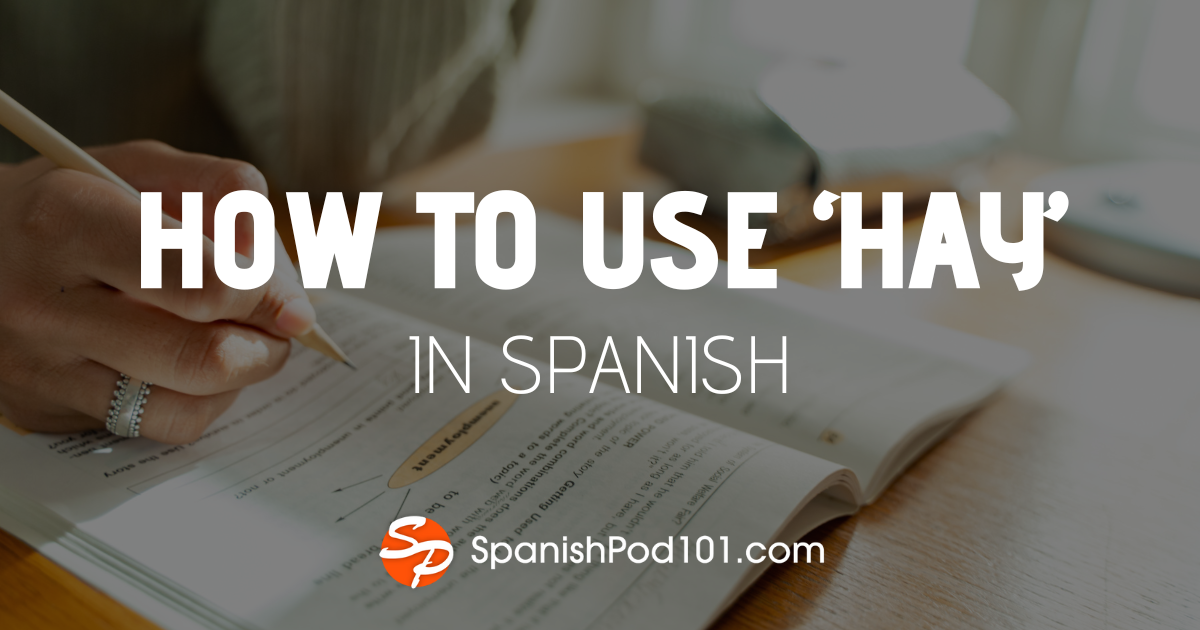You’ve already learned how to say hello in Spanish, so now it’s time to start saying goodbye.
Like in any language, there are many different ways you can say goodbye in Spanish depending on the context. In this article, we’ll teach you common Spanish goodbye phrases for any situation, from formal encounters to leaving a group of friends or ending a phone call. By the end, you’ll be able to recognize many different Spanish goodbyes when you hear them, and understand how to use them yourself to sound more like a native speaker!
- → In addition to this guide, we have a series of activities on SpanishPod101.com for you, so you can put all of this new knowledge into practice.
 Table of Contents
Table of Contents
- Spanish Goodbye Phrases for Formal and Informal Situations
- When to Use Nos vemos (“See you soon”)
- Common Ways to Say Goodbye Before a Long Trip
- How to Say Goodbye When You’re in a Hurry
- Have a Nice Day
- Keep in Touch
- Saying Goodbye from a Distance
- Other Cool Ways to Say Goodbye in Spanish
- Goodbye Idioms in Spanish
- In Conclusion…
1. Spanish Goodbye Phrases for Formal and Informal Situations

The most common word to say “goodbye” in Spanish is adiós, but there are several other options depending on the situation. In particular, the way we say goodbye tends to vary based on how formal or informal the context is.
In English, saying “goodbye” is less formal than wishing someone “farewell,” and the same thing happens in Spanish. While you might say adiós to your friends or acquaintances, this would likely be frowned upon in the context of a formal meeting or job interview.
So what would a more proper Spanish goodbye sound like?
A- Formal Farewells
- Hasta luego. / “See you later.”
This is a more cordial and respectful way to say goodbye to strangers, people in authority, or coworkers you don’t know very well.
- Que esté(s) muy bien. / Literally: “That you will be very well.”
This is a respectful, but slightly more intimate, way to say goodbye to neighbors, acquaintances, friends, colleagues, and strangers. Additionally, you can use this goodbye phrase in both formal and informal contexts.
- Que tengas un buen día. / “Have a good day.”
This phrase is typically used in the morning, specifically when you don’t plan on speaking to the other party for the rest of the day. It’s a cordial but familiar way to say goodbye when ending a conversation with family or friends, or when leaving a(n):
- Office
- Bank
- Supermarket
- Store
B- Informal Farewells
There are two very common Spanish goodbye words that you can use with close friends and family members.
- Adiós. / “Bye.”
You can say this to friends, family, or close coworkers at any time of day. It’s used both in Spain and in Latin America.
- Chao. / “Bye bye.”
As you probably know, this one comes from the Italian word ciao. It’s used in a lot of places in Europe and in Latin America.
2. When to Use Nos vemos (“See you soon”)
Before we go any further, let’s talk about the various ways of saying nos vemos (“see you soon”) in different situations.

This is a very common phrase in Spanish, and it’s used informally with friends and family to indicate that you’ll be seeing each other again.
Examples:
- Hasta luego. / “See you soon.”
This is a more casual and polite way to say goodbye. It’s used to indicate that you’ll meet at a certain time: In the afternoon, tomorrow, next week, another day, etc. In the capital of Spain, Madrid, it’s common to say Hasta luego instead of Adiós, even if you’re not going to see each other again anytime soon.
- Nos vemos. / “See you.”
This one is very similar to Hasta luego, only more informal and reserved for close friends and acquaintances. It’s an open farewell because it doesn’t specify when you’ll see each other again.
- Hasta la vista. / “So long.”
This one is even more informal, and it’s only used between really close friends when they’re unsure of when their next meeting will be.
- Hasta la próxima. / “Until next time.”
This one is similar to “see you,” but it’s a little more polite. You can say it to friends, acquaintances, or strangers. It’s used to indicate that you’ll see each other another time: tomorrow, in a few weeks, in another casual meeting, next month, etc.
3. Common Ways to Say Goodbye Before a Long Trip

That moment when you or a loved one is about to board a plane, train, or bus can be very emotional. Travel often leads to more loving and meaningful goodbyes, regardless of how far away that person is going or how long they’ll be gone. And for each unique situation, there are several ways you could tell your loved one goodbye.
Below are just a few examples of how you can wish a loved one goodbye during those emotional last moments before they leave.
- Adiós. / “Goodbye.”
This is the most popular way to say goodbye in the Spanish language, and the most informal.
- Cuídate mucho. / “Take it easy.”
This phrase expresses your care for the other person, and asks them to take care while they’re away. On many occasions, adiós will be accompanied by cuídate mucho.
- Que te vaya bien. / “Good luck.”
There’s no direct translation for this phrase, but in English, it would be like “Have a good time.” It’s a more familiar way to wish someone well on their trip.
- Mucha suerte. / “Good luck.”
This is similar to que te vaya bien. It’s a cordial way of wishing friends, family, colleagues, or acquaintances the best on their trip.
- Pórtate bien. / “Be nice.”
This is the literal translation of “Behave well.” Native Spanish-speakers often say this to children who are going on a trip.
- Te echaré de menos. / “I will miss you.”
You can use this to say goodbye to your loved ones: parents, children, brothers, partners, best friends. It’s usually accompanied by a strong hug.
- Nos vemos pronto. / “See you soon.”
This is an informal and close way to say goodbye to family, friends, or colleagues to indicate that you’ll see each other again in the near future.
- Buen viaje. / “Good trip.”
Like in English, this is a cordial way to say goodbye to anyone and wish them success on their trip.
4. How to Say Goodbye When You’re in a Hurry

In this section, I’ll show you how to say goodbye in Spanish when you need to leave in a hurry. You may notice while reading that some of the expressions, when translated, are similar to those you would use in English. By the time you finish reading through these, you should have little problem leaving a party, dinner, or meeting before everyone else!
A- Informal
- Adiós, tengo prisa. / “Bye, I’m in a hurry.”
You can use this phrase with friends and family when you need to leave quickly.
- Estoy de afán. Or: Tengo prisa. / “I’m in a hurry.”
Tengo afán is the same as Tengo prisa. The only difference is that the first one is used in Latin American countries and the second one in Spain. It’s an informal phrase you can use when speaking to people you’re close to.
- Tengo que correr. Or: Tengo que volar. / “I have to run.” Or: “I have to fly.” (Literal translation)
This is a colloquial way to say goodbye when you’re in a hurry and can’t stay any longer. Tengo que volar is very common in countries like Colombia.
- Me tengo que ir. / “I have to go.”
You can use this informal expression with friends and family, much like how you would use it in English.
- ¡Es tarde, tengo que irme! / “It’s late, I’d better get / be going!”
This phrase goes a step farther by explaining why you need to leave: it’s late.
- Me voy. / “I’m off.” Or “I’m leaving.”
This is another informal way to say that you’re leaving. You can soften it a bit by explaining your motives first. For example: Bueno, me voy, tengo un día ocupado mañana. In English, this would be: “Anyway, I’m off: I have a busy day tomorrow.”
B- Formal
- Encantado/Encantada de verle de nuevo, espero que otro día podamos hablar con más tiempo!
“It was nice to see you again, hope to catch up soon!”
Just like in English, this is a cordial way to say goodbye to someone in more formal situations. It indicates that it was pleasant to see him/her and that you hope to meet with them again.
- Adiós, espero verte pronto. / “I hope to see you soon. Bye.”
This is a close and warm way to say goodbye to someone whose presence you enjoy, indicating that it would be nice to see him/her again.
5. Have a Nice Day
“Have a nice day!”
I’m betting you say this to someone just about every day. Like in English, this cordial way to say goodbye is also used in Spanish after a short chat with a neighbor, a friend, or even a stranger.

Here are some examples of when or how you might use this phrase:
- In the morning
Imagine you have a short conversation with your neighbor early in the morning. To end the conversation, you may want to wish them a nice rest of their day.
- When greeting someone for the first time
If you run into a friend or coworker early in the morning, they’ll definitely appreciate it if you wish them a nice day.
- When you’re with strangers or colleagues
If you’ve started talking with someone at the store, bank, or library, wishing them a nice day is a polite way to end the conversation.
- “Have a good day.” / Que te vaya bien.
This phrase literally translates as “May it go well to you.” This is a good way to wish friends or family well in their upcoming activities for the day.
In countries like Colombia or in Barcelona, Spain, people may say: Que vaya bien. It literally means: “May it go well to.” It’s always appropriate to respond with gracias (“thank you”), and to return the wish, you can also say igualmente (“likewise”).
6. Keep in Touch
Here are some Spanish goodbye phrases you can use to let the other person know you want to keep in touch!
- Te veo al rato. Or: Te veo luego. / “I’ll see you in a bit.”
- Te veo después. / “Catch you later.” Or: “See you later.”
- Te veo pronto. / “See you soon.” (nearby)
- Seguimos en contacto. / “Keep in touch.” (formal)
- Hasta la próxima. / “Until next time.”
- Hasta pronto. / “See you soon.” (formal)
Note: In Spain, you may also hear the phrase hasta ahora which literally means “until now.” This expression is very typical of the country and is said to anyone, regardless of whether they’ll see each other again or not.
7. Saying Goodbye from a Distance
Our communication revolves around the internet and social networks, both of which have also changed the way in which we talk to each other. For example, thanks to emoticons and emojis, language is much more universal and less limited.
It’s fun, right?
But it’s cooler to be able to express yourself with confidence and sound like a native. That’s why I’m going to leave you with some of the most commonly used expressions for saying goodbye in Spanish from a distance.
A- Over the Phone
- Adiós. / “Bye.”
- Besos. / “Kisses.” Or: Un beso. / “A kiss.”
- Hablamos. / Translated literally, it means “We talk,” but it really means “Keep in touch.”
B- By Mail
i. Formal
Here are some phrases you can use if the message is work-related or otherwise formal in nature.
- Espero su respuesta.
“I look forward to hearing from you.”
- Cualquier duda, no dude en contactarme.
“If you have any questions, do not hesitate to contact me.”
- Saludos cordiales.
“Best regards.”
- Seguimos en contacto.
“Keep in touch.”
ii. Informal
And here are phrases to use if you’re contacting someone about a personal topic, such as to give an announcement or to wish then congratulations.
- Mis mejores deseos.
“Best wishes.”
- Saludos.
“Cheers.”
C- Text Messages
- Adiós.
“Bye.”
- Hablamos luego.
“Let’s talk later.”
D- Chat
This is the most popular way to communicate with people. Although it’s more common to use with relatives, there are some cases where you might be chatting with a stranger. Here are some good expressions you can use:
- Nos vemos.
“See you later.”
- Adiós.
“Bye.”
- Besos.
“Kisses.”
- Cuídate.
“Take care.”
- Chao.
“Bye.”
If the context is a bit more formal:
- Feliz día. / Feliz noche.
“Have a good day.” / “Have a good night.”
- Seguimos en contacto.
“Keep in touch.”
8. Other Cool Ways to Say Goodbye in Spanish
Some countries use very cultural expressions to say thank you and goodbye, especially in work-related environments:
- Gracias por trabajar duro. / “Thanks for working hard.”
This phrase is popular in Asian countries to acknowledge someone’s hard work.
- Buen viento y buena mar. / “Good wind and good sea.”
This one is popular in Latin America. It’s used to say goodbye when someone will be changing jobs soon or leaving the company.
9. Goodbye Idioms in Spanish
In Spain, although the official language is Spanish, there are different regions that use their own dialect. For example, they speak Gallego in Galicia and Catalonian in Catalan. Each country has particular ways of saying goodbye that you can only understand if you’re immersed in the culture. Let’s look at some of the most common examples:
- Hasta luego Lucas.
This is a fun way to say goodbye in Spanish. It’s used informally and usually among friends.
- Me piro. / Me abro.
The expression “Bueno, ¡me piro!” is widely used in Spain in very familiar environments and never with strangers. Me abro is the same, but it’s used more in countries like Colombia.

- Ahí te quedas.
This literally translates to: “That is where you stay.” It indicates that you’re leaving the other person at the moment so you can go about doing other things. It’s used in the area of Malaga in Spain and in some countries of Latin America, like Colombia.
- Adéu.
This is a Catalan expression that’s normally used by the natives of Barcelona to say goodbye. It can be used with friends or strangers.
- Ciao.
This is the official way to say goodbye in Italian, though many other languages have adopted this phrase.
- Ahueco el ala.
This one is a very colloquial way of saying goodbye or telling someone to leave. Its literal English translation is: “I cup the wing,” which, as it turns out, doesn’t make much sense. But in the local language, it really means something like “I’m off.”
Ahueco el ala is used in Spain, Colombia, and Mexico. Keep in mind that it should only be used with people you know well, and never with strangers.
10. In Conclusion…
In this guide, you’ve learned the most common ways to say goodbye in Spanish, from casual expressions to more formal ones. In addition, you saw several idioms from a variety of Spanish-speaking countries; this will certainly help you immerse yourself in the culture!
Do you feel ready to continue your journey of language exploration? Remember that at SpanishPod101.com, you’ll find many more lessons like this one to keep your vocabulary fresh and your grammar knowledge on-point!










